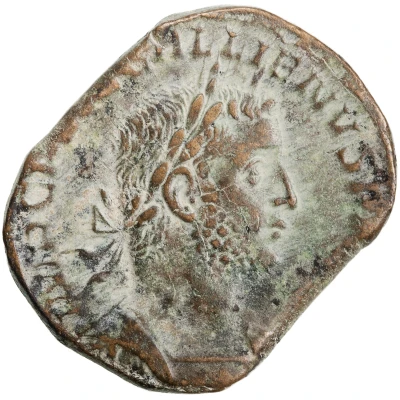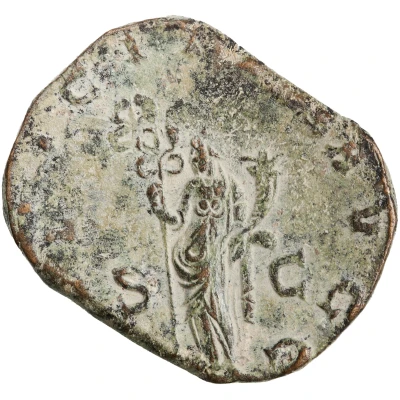


© American Numismatic Society (ANS)
Sestertius - Gallienus FELICITAS AVGG S C; Felicitas
| Bronze | 16.4 g | 28.5 mm |
| Issuer | Rome › Roman Empire (27 BC - 395 AD) |
|---|---|
| Emperor | Gallienus (Publius Licinius Egnatius Gallienus) (253-268) Valerian (Publius Licinius Valerianus) (253-260) |
| Type | Standard circulation coin |
| Years | 255-256 |
| Value | Sestertius (⅛) |
| Currency | Antoninianus, Reform of Caracalla (AD 215 – 301) |
| Composition | Bronze |
| Weight | 16.4 g |
| Diameter | 28.5 mm |
| Shape | Round (irregular) |
| Technique | Hammered |
| Demonetized | Yes |
| Updated | 2024-10-05 |
| Numista | N#286843 |
|---|---|
| Rarity index | 97% |
Reverse
Felicitas, draped, standing left, holding caduceus in right hand and cornucopiae in left hand.
Script: Latin
Lettering: FELICITAS AVGG S C
Translation:
Felicitas Duorum Augustorum. Senatus Consultum.
Good fortune of the two emperors (Augusti). Decree of the senate.
Comment
Mass varies: 14.75–18.95 g;Diameter varies: 27–29.7 mm;
Example of this type:
American Numismatic Society (ANS)
Source:
Online Coins of the Roman Empire (OCRE)
Interesting fact
One interesting fact about this coin is that it features an image of Felicitas, the Roman goddess of good luck and prosperity, on one side, while the other side bears the image of Gallienus, the Roman emperor who ruled from 253 to 268 AD. This coin was minted during a time of great turmoil in the Roman Empire, marked by constant wars, political instability, and economic difficulties. Despite these challenges, the coinage of Gallienus' reign is notable for its high artistic quality and the use of new techniques, such as the use of bronze instead of the more traditional gold or silver. This coin, in particular, is a testament to the enduring power of the Roman Empire, even in the face of adversity.

